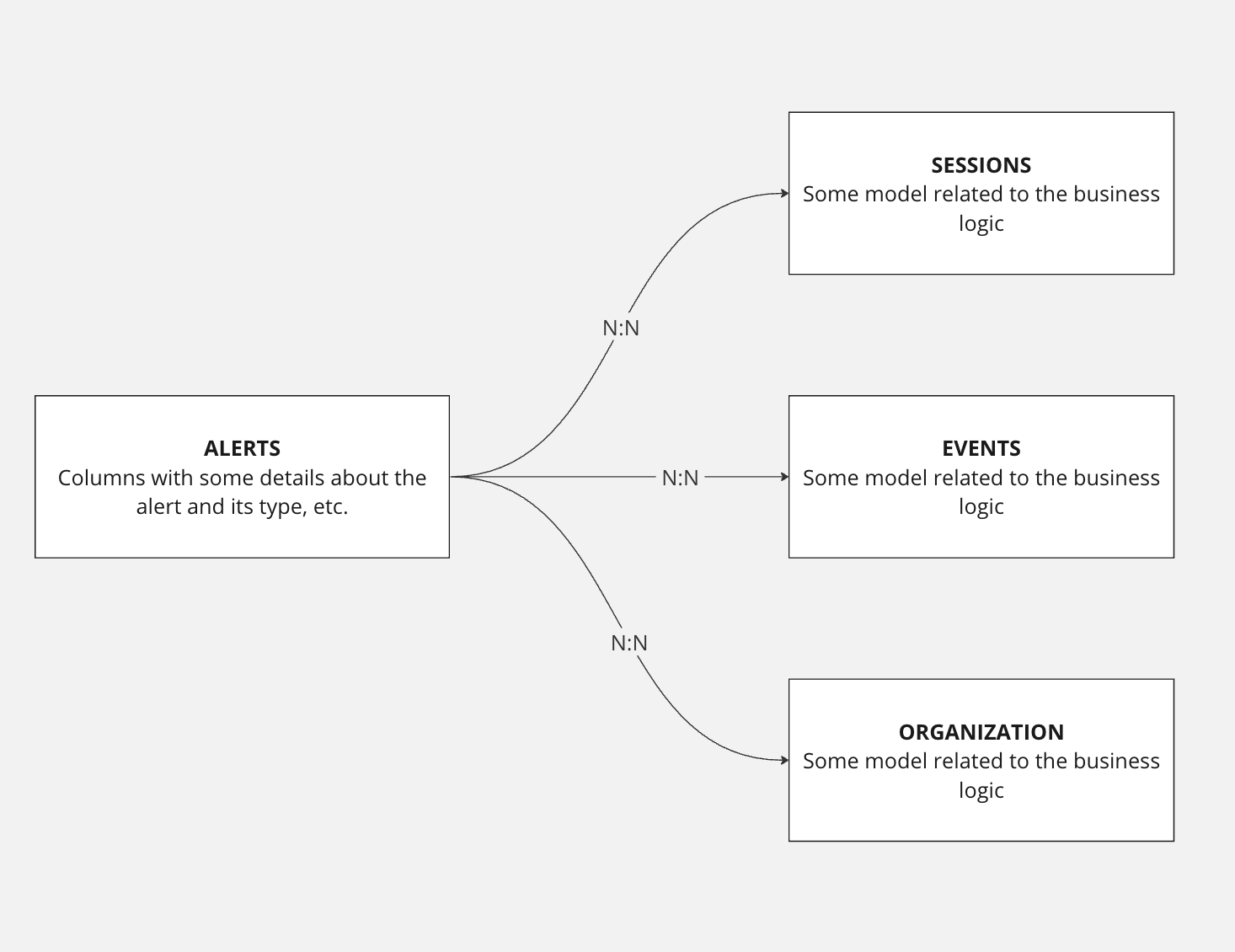Alerting system relationships and STI in PostgreSQL
0
votes
1
answer
28
views
I'm no expert in DBMS and trying to build up **an alerting system that can attach itself to many tables**, so I figured asking the question would help my architecture.
 The thing that may confuse me a little is that you can have multiple alerts attached to **each model** (sessions, events, organization) that are represented in tables in my database. One record of each model can have multiple different alerts ringing up.
The simplest way to solve this is to create a table such as
The thing that may confuse me a little is that you can have multiple alerts attached to **each model** (sessions, events, organization) that are represented in tables in my database. One record of each model can have multiple different alerts ringing up.
The simplest way to solve this is to create a table such as
 The thing that may confuse me a little is that you can have multiple alerts attached to **each model** (sessions, events, organization) that are represented in tables in my database. One record of each model can have multiple different alerts ringing up.
The simplest way to solve this is to create a table such as
The thing that may confuse me a little is that you can have multiple alerts attached to **each model** (sessions, events, organization) that are represented in tables in my database. One record of each model can have multiple different alerts ringing up.
The simplest way to solve this is to create a table such as
CREATE TABLE alerts (
id uuid DEFAULT uuid_generate_v4() PRIMARY KEY,
alert_type character varying(50) NOT NULL,
metadata jsonb,
session_id uuid REFERENCES sessions(id) ON DELETE DO NOTHING ON UPDATE CASCADE,
event_id uuid REFERENCES events(id) ON DELETE DO NOTHING ON UPDATE CASCADE,
organization_id uuid REFERENCES organizations(id) ON DELETE DO NOTHING ON UPDATE CASCADE,
created_at timestamp without time zone,
updated_at timestamp without time zone
);alerts and to represent the many-to-many a second table alerts_relations that has table_name and table_id to make sense of each other model/table it's attached to.
CREATE TABLE alerts (
id uuid DEFAULT uuid_generate_v4() PRIMARY KEY,
alert_type character varying(50) NOT NULL,
metadata jsonb,
created_at timestamp without time zone,
updated_at timestamp without time zone
);
CREATE TABLE alerts_relations (
id uuid DEFAULT uuid_generate_v4() PRIMARY KEY,
alert_id uuid REFERENCES alerts(id) ON DELETE CASCADE ON UPDATE CASCADE,
table_name character varying(50) NOT NULL,
table_id character varying(50) NOT NULL,
created_at timestamp without time zone,
updated_at timestamp without time zone
);table_name and table_id and replace it with the following
CREATE TABLE session_alerts (
session_id uuid REFERENCES sessions(id) ON DELETE CASCADE ON UPDATE CASCADE
) INHERITS (alert_relations);
CREATE TABLE event_alerts (
event_id uuid REFERENCES events(id) ON DELETE CASCADE ON UPDATE CASCADE
) INHERITS (alert_relations);
CREATE TABLE organization_alerts (
organization_id uuid REFERENCES organizations(id) ON DELETE CASCADE ON UPDATE CASCADE
) INHERITS (alert_relations);
Asked by Laurent
(101 rep)
Dec 2, 2023, 08:23 PM
Last activity: Dec 7, 2023, 02:45 AM
Last activity: Dec 7, 2023, 02:45 AM